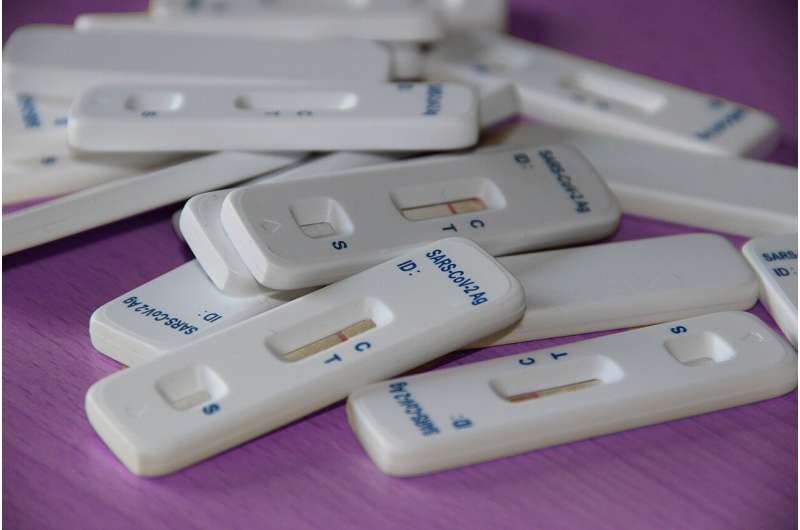This article has been reviewed according to Science X's editorial process and policies. Editors have highlighted the following attributes while ensuring the content's credibility:
fact-checked
trusted source
proofread
Study: At-home rapid COVID tests may miss many infections

For the last couple of years, the rapid at-home COVID tests that can identify an infection with a simple swab of the nose have been a mainstay of efforts to diagnose infection with the SARS-CoV-2 virus and prevent its spread.
But what if these tests are often wrong?
New research conducted at Caltech suggests that in many cases, rapid tests that use a nasal swab provide false negatives—suggesting that a person is infection-free even though other parts of their respiratory tract are teeming with the virus. The findings, from the lab of Rustem Ismagilov, Ethel Wilson Bowles and Robert Bowles Professor of Chemistry and Chemical Engineering, appear in a paper published in the journal Microbiology Spectrum on June 15 .
Researchers in Ismagilov's lab tracked viral loads in three places in the human body during the course of a COVID-19 infection: the nose, the throat, and the mouth. Because the nose, throat, and mouth are so closely connected, one might expect to see similar virus levels in those locations. That turns out not to be the case.
"Generally, we saw that most people have virus first appear in their throat and in saliva, and then, sometimes days later, in their nose," says Alexander Viloria Winnett, biology graduate student and study co-author. "Actually, each sample type from a single person follows its own distinct rise and fall of viral load, so it makes a big difference which sample type is used for testing."
At the beginning of the pandemic, the gold standard for testing was the deep nasal swab (PCR test) administered by a medical professional, which is highly sensitive and accurate but uncomfortable for many people and slower to provide results. As the pandemic progressed, people more and more relied on at-home nasal rapid antigen tests, which can be performed without the assistance of a medical professional and provide results in as little as 15 minutes.
However, in their study, the Caltech researchers found that most people showed a delay of several days between when the virus first appeared in the throat or saliva and when it appeared in the nose. Importantly, 15 of the 17 study participants had high and presumably infectious levels of virus for at least a day prior to getting a positive antigen test.
"In one individual, levels of virus in throat swabs were extremely high and presumably infectious for almost two weeks while nasal-swab viral loads were undetectable or remained so low they would have been detected only by a highly sensitive PCR test," says Natasha Shelby, the Caltech COVID-19 study's administrator and a co-author on the paper. "This individual never tested positive on her daily rapid antigen tests."
Shelby says antigen tests have two major limitations: "First, they only test for virus in the nose, even though the SARS-CoV-2 virus is known to be in the mouth, and, in fact, numerous studies show it often shows up in the mouth days before the nose. Second, these rapid tests have low sensitivity, which means they require a lot of virus to indicate a positive result. People assume that these tests will be positive when people are infectious, but we now know from numerous studies that this is not always true."
That means at-home tests can indicate that a person is negative for the virus even though they are actually infected—and even currently infectious.
"Rapid tests have some benefits. You can get results in about 20 minutes, they tend to be less expensive, and they can be more portable than other testing methods," Viloria Winnett says. "But because they are only approved for nasal swabs and have low sensitivity, correct detection of infection by those tests is often delayed by several days."
Viloria Winnett says he hopes the Caltech COVID-19 study findings will spur development of home testing kits that sample both the nose and throat. Such tests are common in other parts of the world, such as the United Kingdom, but are not authorized for use in the United States.
"This has implications," Viloria Winnett says. "People are still becoming infected with COVID. We're still seeing waves, and we're still seeing the development of new variants. I don't want to be alarmist, but we still need to be aware and reactive to the pandemic. And hopefully this work can inform our initial response to other upper respiratory viruses that may emerge so testing strategies can be more effective."
Exactly why such different viral trajectories are seen in these parts of the body remains an open question that will have to be the subject of future research.
"Why is there virus in a certain sample type and not in another? It could be the route of initial infection or susceptibility of different anatomical sites to the virus. This is what I'll be trying to figure out in follow-up investigations," Viloria Winnett says.
More information: Alexander Viloria Winnett et al, Daily SARS-CoV-2 Nasal Antigen Tests Miss Infected and Presumably Infectious People Due to Viral Load Differences among Specimen Types, Microbiology Spectrum (2023). DOI: 10.1128/spectrum.01295-23



















